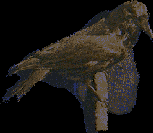

Poe's poems such as "To Helen," "Lenore," and "The Raven," investigate the loss of beauty and the difficultly in regaining it. These pieces are usually narrated by a young man who laments the death of his beloved.(Young 418) "The Raven" is Edgar Allan Poe's most famous poem because he wrote "The Philosophy of Composition," an essay reconstructing the step-by-step process of how he composed the poem. In this essay he talks about how the structure of the ballad and the rhythm used in it create the maddening of the narrator.
"The Raven" is a ballad of eighteen six-line stanzas with emphatic meter and rhymes. The ballad tells about a young man who, depressed by the death of the woman he loved, constructs self-destructive meaning around a raven's repetition of the word "Nevermore," until he finally despairs of being reunited with his beloved Lenore in another world.(Young 418) Narrated from first person point of view, the narrator's tone in the ballad switches from weariness to nervousness. At first, the narrator thinks the bird is saying "Nevermore" because his former master taught him how to say the word. As the narrator begins to ponder the meaning of the word, he begins to think the raven is a messenger that was sent to induce the loss of Lenore. The raven's predictable answer provokes the grieving lover, who is in a maddened frenzy, to ask if he will ever be reunited with his lover in heaven and the raven answers "Nevermore." The raven becomes a permanent fixture in the room of the narrator at the end of the ballad because the presence of the bird symbolizes the narrator's loss of sanity.
Fear of darkness, horror of madness, abhorrence of decay, the crippling sensations, which we tend to keep locked in our subconscious minds, Poe touched like a needle hitting a nerve.(Sinclair 10) In his tales we can see our nightmares and his characters are our blackest visions of ourselves and their situation are things of our worst imaginings.(Sinclair 10) Poe's ballad, "The Raven" ventures deep into the narrator's tortured soul and uncovers the emptiness that haunts his mind. The narrator's subconscious mind burdened with thoughts and feelings of his dead lover, Lenore and her death which has left him devastated and alone. Poe's narrator says "I stood there, wondering, fearing, doubting, dreaming dreams no mortals ever dared to dream before"(Poe ln.25-26) because his mind concocts strange reasons to explain why the raven answers his questions with the word, "Nevermore." The meaningless word sparks strange ideas and feelings in the narrator's mind and causes him to despise the presence of the bird. The raven has been a bird of ill omen since Roman times, a harbinger of bad luck, disease and death and in "The Raven" the narrator has one knocking at his chamber door.
Poe felt that his whole life was a warning of some terrible fate to come and because of this, he was obsessed with death. Poe's narrator, in "The Raven," begins his gloomy exploration of death in the first stanzas of the ballad.(Young 418) For example, the setting of his story takes place on a "dreary"(Poe ln.1) night and the narrator feels "weak and weary."(Poe ln.1) Throughout the entire ballad, Poe shows images of death in his description of the bird and himself. In stanza 18, for example, when the narrator has reached a point of total insanity, he says "the Raven, never flitting, still is sitting, still is sitting..his eyes all the seeming of a demon's that is dreaming....And my soul from that shadow that lies floating on the floor Shall be lifted--Nevermore."(Poe ln.102-108) The image of death is portrayed in these lines because the narrator, who is in a state of delirium, asks the demon-like bird if his soul will be preserved in heaven. The raven answers him "Nevermore." Death, a major theme in Gothic writing, is the focus of Poe's ballad.
"back home"Click to view "The Raven"
